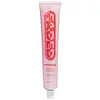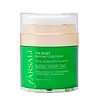What's inside
What's inside
 Key Ingredients
Key Ingredients

 Benefits
Benefits

 Concerns
Concerns

 Ingredients Side-by-side
Ingredients Side-by-side

Water
Skin ConditioningCaprylic/Capric Triglyceride
MaskingGlycerin
HumectantNiacinamide
SmoothingButyrospermum Parkii Butter
Skin ConditioningTranexamic Acid
AstringentGlyceryl Stearate
EmollientArbutin
AntioxidantSimmondsia Chinensis Seed Oil
EmollientBehenyl Alcohol
EmollientGlyceryl Behenate
EmollientKojic Acid
AntioxidantOxidized Glutathione
EmollientPhenoxyethanol
PreservativeCeteareth-20
CleansingLecithin
EmollientSclerotium Gum
Emulsion StabilisingZinc Ricinoleate
Arginine Hcl
Skin ConditioningAzelaic Acid
BufferingSqualane
EmollientCeteareth-12
EmulsifyingCetearyl Alcohol
EmollientCetyl Palmitate
EmollientTetrahydroxypropyl Ethylenediamine
Curcuma Longa Callus Extract
Skin ProtectingSodium Lauroyl Sarcosinate
CleansingTrisodium Ethylenediamine Disuccinate
Phytic Acid
Allantoin
Skin ConditioningDimethylmethoxy Chromanyl Palmitate
Skin ConditioningEthylhexylglycerin
Skin ConditioningCentella Asiatica Leaf Extract
Skin ConditioningMelatonin
AntioxidantGlycyrrhiza Glabra Root Extract
BleachingWater, Caprylic/Capric Triglyceride, Glycerin, Niacinamide, Butyrospermum Parkii Butter, Tranexamic Acid, Glyceryl Stearate, Arbutin, Simmondsia Chinensis Seed Oil, Behenyl Alcohol, Glyceryl Behenate, Kojic Acid, Oxidized Glutathione, Phenoxyethanol, Ceteareth-20, Lecithin, Sclerotium Gum, Zinc Ricinoleate, Arginine Hcl, Azelaic Acid, Squalane, Ceteareth-12, Cetearyl Alcohol, Cetyl Palmitate, Tetrahydroxypropyl Ethylenediamine, Curcuma Longa Callus Extract, Sodium Lauroyl Sarcosinate, Trisodium Ethylenediamine Disuccinate, Phytic Acid, Allantoin, Dimethylmethoxy Chromanyl Palmitate, Ethylhexylglycerin, Centella Asiatica Leaf Extract, Melatonin, Glycyrrhiza Glabra Root Extract
Water
Skin ConditioningPropanediol
SolventCaprylic/Capric Triglyceride
MaskingGlycerin
HumectantTetrahexyldecyl Ascorbate
AntioxidantNiacinamide
SmoothingSqualane
EmollientDiheptyl Succinate
EmollientLactic Acid
BufferingSodium Hyaluronate
HumectantHydroxyethyl Acrylate/Sodium Acryloyldimethyl Taurate Copolymer
Emulsion StabilisingRosa Canina Fruit Oil
EmollientCetyl Stearate
EmollientIsostearyl Isostearate
EmollientPotassium Cetyl Phosphate
EmulsifyingAllantoin
Skin ConditioningAcetyl Hexapeptide-8
HumectantAcetyl Octapeptide-3
HumectantAcetyl Tetrapeptide-2
Skin ConditioningCopper Tripeptide-1
Skin ConditioningNonapeptide-1
Skin ConditioningPalmitoyl Tetrapeptide-7
Skin ConditioningPalmitoyl Tripeptide-1
Skin ConditioningPalmitoyl Tripeptide-38
Skin ConditioningPentapeptide-18
Skin ConditioningCeramide As
Skin ConditioningCeramide AP
Skin ConditioningCeramide Ns
Skin ConditioningCholesterol
EmollientPentapeptide-28
Skin ConditioningPolyacrylate Crosspolymer-6
Emulsion StabilisingCeramide NP
Skin ConditioningCeramide EOP
Skin ConditioningCapryloyl Glycerin/Sebacic Acid Copolymer
Skin ConditioningTocopheryl Acetate
AntioxidantSorbitan Isostearate
EmulsifyingSodium Phytate
Centella Asiatica Extract
CleansingButylene Glycol
HumectantAloe Barbadensis Leaf Juice
Skin ConditioningSodium Benzoate
MaskingSodium Hydroxide
BufferingPotassium Sorbate
PreservativeCarbomer
Emulsion StabilisingCetyl Alcohol
EmollientStearic Acid
Cleansing1,2-Hexanediol
Skin ConditioningBeta-Glucan
Skin ConditioningCaprylyl Glycol
EmollientEuterpe Oleracea Fruit Extract
Porphyridium Cruentum Extract
Skin ConditioningPanax Ginseng Root Extract
EmollientCarica Papaya Fruit Extract
Skin ConditioningLupinus Albus Seed Extract
Skin ConditioningCurcuma Longa Root Extract
MaskingHydrogenated Lecithin
EmulsifyingAstragalus Membranaceus Root Extract
EmollientCamellia Sinensis Leaf Extract
AntimicrobialDipropylene Glycol
HumectantGlyceryl Stearate
EmollientSucrose Distearate
EmollientWater, Propanediol, Caprylic/Capric Triglyceride, Glycerin, Tetrahexyldecyl Ascorbate, Niacinamide, Squalane, Diheptyl Succinate, Lactic Acid, Sodium Hyaluronate, Hydroxyethyl Acrylate/Sodium Acryloyldimethyl Taurate Copolymer, Rosa Canina Fruit Oil, Cetyl Stearate, Isostearyl Isostearate, Potassium Cetyl Phosphate, Allantoin, Acetyl Hexapeptide-8, Acetyl Octapeptide-3, Acetyl Tetrapeptide-2, Copper Tripeptide-1, Nonapeptide-1, Palmitoyl Tetrapeptide-7, Palmitoyl Tripeptide-1, Palmitoyl Tripeptide-38, Pentapeptide-18, Ceramide As, Ceramide AP, Ceramide Ns, Cholesterol, Pentapeptide-28, Polyacrylate Crosspolymer-6, Ceramide NP, Ceramide EOP, Capryloyl Glycerin/Sebacic Acid Copolymer, Tocopheryl Acetate, Sorbitan Isostearate, Sodium Phytate, Centella Asiatica Extract, Butylene Glycol, Aloe Barbadensis Leaf Juice, Sodium Benzoate, Sodium Hydroxide, Potassium Sorbate, Carbomer, Cetyl Alcohol, Stearic Acid, 1,2-Hexanediol, Beta-Glucan, Caprylyl Glycol, Euterpe Oleracea Fruit Extract, Porphyridium Cruentum Extract, Panax Ginseng Root Extract, Carica Papaya Fruit Extract, Lupinus Albus Seed Extract, Curcuma Longa Root Extract, Hydrogenated Lecithin, Astragalus Membranaceus Root Extract, Camellia Sinensis Leaf Extract, Dipropylene Glycol, Glyceryl Stearate, Sucrose Distearate
 Reviews
Reviews

Ingredients Explained
These ingredients are found in both products.
Ingredients higher up in an ingredient list are typically present in a larger amount.
Allantoin is a soothing ingredient known for its protective and moisturizingg properties. Because of this, it is often added to products with strong active ingredients.
Studies show higher concentrations of this ingredient can promote wound healing.
Though it can be derived from the comfrey plant, allantoin is produced synthetically for cosmetic products to ensure purity.
Learn more about AllantoinThis ingredient is an emollient, solvent, and texture enhancer. It is considered a skin-softener by helping the skin prevent moisture loss.
It helps thicken a product's formula and makes it easier to spread by dissolving clumping compounds.
Caprylic Triglyceride is made by combining glycerin with coconut oil, forming a clear liquid.
While there is an assumption Caprylic Triglyceride can clog pores due to it being derived from coconut oil, there is no research supporting this.
Learn more about Caprylic/Capric TriglycerideGlycerin is already naturally found in your skin. It helps moisturize and protect your skin.
A study from 2016 found glycerin to be more effective as a humectant than AHAs and hyaluronic acid.
As a humectant, it helps the skin stay hydrated by pulling moisture to your skin. The low molecular weight of glycerin allows it to pull moisture into the deeper layers of your skin.
Hydrated skin improves your skin barrier; Your skin barrier helps protect against irritants and bacteria.
Glycerin has also been found to have antimicrobial and antiviral properties. Due to these properties, glycerin is often used in wound and burn treatments.
In cosmetics, glycerin is usually derived from plants such as soybean or palm. However, it can also be sourced from animals, such as tallow or animal fat.
This ingredient is organic, colorless, odorless, and non-toxic.
Glycerin is the name for this ingredient in American English. British English uses Glycerol/Glycerine.
Learn more about GlycerinGlyceryl Stearate is a mix of glycerin and stearic acid.
It is used to stabilize the mixing of water and oil ingredients. By preventing these ingredients from separating, it can help elongate shelf life. It can also help thicken the product's texture.
As an emollient, it helps soften skin and supports barrier-replenishing ingredients.
In cosmetics, Glyceryl Stearate is often made from vegetable oils or synthetically produced.
This ingredient may not be fungal-acne safe
Fun fact: The human body also creates Glyceryl Stearate naturally.
Learn more about Glyceryl StearateNiacinamide is a multitasking form of vitamin B3 that strengthens the skin barrier, reduces pores and dark spots, regulates oil, and improves signs of aging.
And the best part? It's gentle and well-tolerated by most skin types, including sensitive and reactive skin.
You might have heard of "niacin flush", or the reddening of skin that causes itchiness. Niacinamide has not been found to cause this.
In very rare cases, some individuals may not be able to tolerate niacinamide at all or experience an allergic reaction to it.
If you are experiencing flaking, irritation, and dryness with this ingredient, be sure to double check all your products as this ingredient can be found in all categories of skincare.
When incorporating niacinamide into your routine, look out for concentration amounts. Typically, 5% niacinamide provides benefits such as fading dark spots. However, if you have sensitive skin, it is better to begin with a smaller concentration.
When you apply niacinamide to your skin, your body converts it into nicotinamide adenine dinucleotide (NAD). NAD is an essential coenzyme that is already found in your cells as "fuel" and powers countless biological processes.
In your skin, NAD helps repair cell damage, produce new healthy cells, support collagen production, strengthen the skin barrier, and fight environmental stressors (like UV and pollution).
Our natural NAD levels start to decline with age, leading to slower skin repair, visible aging, and a weaker skin barrier. By providing your skin niacinamide, you're recharging your skin's NAD levels. This leads to stronger, healthier, and younger looking skin.
Another name for vitamin B3 is nicotinamide. This vitamin is water-soluble and our bodies don't store it. We obtain Vitamin B3 from either food or skincare. Meat, fish, wheat, yeast, and leafy greens contain vitamin B3.
The type of niacinamide used in skincare is synthetically created.
Learn more about NiacinamideSqualane is an emollient that helps the skin hold onto moisture. It's an oily liquid that occurs naturally in certain types of fish and plant oils.
Because squalane boosts hydration in the skin, it also comes with plenty of benefits: it is an antioxidant and can help fight free radicals and skin damage. Squalane is also found to have a detoxifying effect when applied.
Squalane comes from squalene, which occurs naturally within the sebum of our skin. It is one of the oils our skin produces to keep itself hydrated. Squalane is the hydrogenated version of squalene and has a longer shelf life.
Research shows that squalane is non-irritating (even at 100% concentration).
In general, it's a fantastic ingredient. It does a great job at hydrating the skin, and it's suitable for those with sensitive skin.
The source of squalane may impact malassezia / fungal acne. This is because olive oil derived squalane can contain impurities such as fatty acids and plant waxes. Sugarcane derived squalane is recommended for anyone with malassezia concerns.
Is squalane vegan?
This depends on the source. Squalane can be derived from both plants and animals. Most squalane used in skincare comes from plants.
Please note: the source of squalane is only known if disclosed by the brand. We recommend reaching out to the brand if you have any questions about their squalane.
Read more about squalene with an "e".
Is squalane an oil?
Squalane is often called an oil, but it’s technically not; it’s a hydrocarbon, meaning it’s only made of carbon and hydrogen, unlike true oils which are triglycerides made of fatty acids and glycerol.
The term “oil-free” isn’t regulated, so companies can define it however they want. Some exclude all oils, while others just avoid mineral oil or comedogenic oils.
While some people avoid oils thinking they cause breakouts, the right kind of oil (or oil-like ingredient like squalane) can actually help balance and hydrate your skin. It’s worth testing out simple oils or squalane to see what works best for your skin.
Learn more about SqualaneWater. It's the most common cosmetic ingredient of all. You'll usually see it at the top of ingredient lists, meaning that it makes up the largest part of the product.
So why is it so popular? Water most often acts as a solvent - this means that it helps dissolve other ingredients into the formulation.
You'll also recognize water as that liquid we all need to stay alive. If you see this, drink a glass of water. Stay hydrated!
Learn more about Water